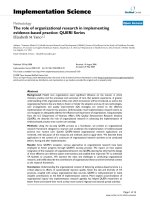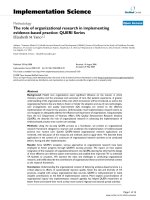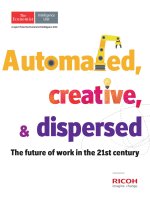The Publication of Scientific Research in the 21st Century
Bạn đang xem bản rút gọn của tài liệu. Xem và tải ngay bản đầy đủ của tài liệu tại đây (3.99 MB, 84 trang )
The Publication of
Scientific Research in
the 21st Century
Jerry R. Miller
ACCDON, LLC
www.letpub.com
Scope of the Presentation
Overview of the Past, Current, and Future
State of English Journal Publishing
Examination of the Review Process from
The Scientists Editor‟s and Reviewer‟s Perspective
Frequent Organizational and Writing Errors
Tips for Successful Writing in the
21st Century
www.letpub.com
Science
Definition (Oxford Dictionary): The intellectual and
practical activity encompassing the systematic study of
the structure and behavior of the physical and natural
world through observation and experiment
Synonym: Body of knowledge/information
(Published Works)
Hypotheses
Testing &
Analyses
www.letpub.com
Sharing
Your Results
Communication
& Publication
Hierarchy in the Distribution of
Scientific Results
Higher Top General Interest Journals
Higher
(Science, Nature)
Order
Of
Preference
Best Journals in the Field of Study
(most widely read and cited)
Other Journals
Quality
Refereed Books
Lower
Conference Proceedings and Other
Books & Book Chapters
Modified From Randal Filer, Iset Policy Institute
www.letpub.com
Lower
Journals versus Book Chapters
Journals
Book Chapters
Editorial Goals: Journal editors are
looking for something new and
original that will receive
considerable interest and citations
(drives impact factors)
Editorial Goals: Book editors are
looking for materials that sells to
as large of audience as possible
Advantages
Peer review typically significant
More widely distributed
Cited and read more frequently
More available online
Disadvantages
Page and figure limitations
Advantages
Typical less restrictive on
length and figures
Author association with topic
Disadvantages
Lower quality reviews
Less reputable
Less well distributed
Often require longer
publication times
Less availability online
www.letpub.com
First Scientific
Writings
• First paper was published on 6
March 1665 in the Philosophical
Transactions of the Royal
Society
• Published by the “Royal Society
of London for Improving
Natural Knowledge””
• Granted charter to publish by
King Charles II
• Intent was to inform “the
Fellows of the Society and
other interested readers of
the latest scientific
discoveries”
From:
/>
www.letpub.com
Peer-Reviewed Journals
Number of Articles Published
•
•
•
•
~28,100 peer-reviewed
journals (all fields) (Plume &
Van Weijen, 2014)
Publish ~2.5 million articles
per year
~3.5-4.5 % increase in
published articles
CrossRef database includes
~55 million journal articles
Increase in Journal Titles
First
Journal
Mabe, 2003
www.letpub.com
Articles Published
In Thousands
English Language Journals
China 17 %
of total
Thomson Reuter‟s Journal Citation
Reports (most cited journals)
• 10,900 journals
• 2,550 publishers
• 8,700 are science related
• 3,200 are social science related
• 1.5 million articles published per year
collectively
Peer-Reviewed Journals
Method of sharing data and discoveries
Maintain quality of science – allow only sound
research to be disseminated
Serve as an archive for scientific data and
discovery
Provide author services
Register author‟s findings/discoveries
(precedence)
Serves as a indicator of researcher‟s impacts
on field
STM stated that the primary reasons for
publishing was to obtain funding and
furthering author‟s career.
www.letpub.com
Publishers
• Wide range of publishers
Globally, 5000-10000 journal publishers
~650 main English-language publishers
73 % are not-for-profit
Only Publish 20 % of journals
80 % of journals published by for-profit
publishers
9,240 journal of total 11,550 (English)
Elsevier - ~25 % of total science titles
• Revenues are often high – US $25.2 Billion
• US $10 Billion for journals
• US $5 Billion in books
Data from STM, 2015
www.letpub.com
Publishers
• Expenses are relatively low
Submitted manuscripts are free
Publishers rely heavily on free labor
provided by associate editors,
editorial boards, and reviewers
• Profit margins varies significantly (can be
30 – 40%)
• Different Business Models Exist
Traditional (copyright/subscription)
based model
Open Access
ebooks/chapter approaches
www.letpub.com
Publishers MUST Receive Papers
They Can Accept to Remain in Business
Citations Serve as Currency
(Impact Factors)
Submissions
Based on Reputation,
Readership, and Quality
Scientists want
to be recognized
Scientists Strive for
Readership and Citations
www.letpub.com
Impact Factor
Formulated by Eugene Garfield, founder of the Institute of
Scientific Information (ISI)
Produced by Thomson Reuters and Published Annually in the
ISI Citations Reports (starting in 1975), for journals indexed
in ISI databases (Web of Science/Knowledge)
It is the average number of times each paper published in
that journal is cited during the preceding two years by other
indexed journals
Example:
Impact Factor 2014
www.letpub.com
=
# of times that all papers
published in journal in 2012 &
2013 were cited in indexed
journals 2014
# of articles published in that
journal in 2012 & 2013
Impact of Increased
Publication Volume on
Scientists
Xfep.com
Fallout of digital publishing and distribution
Access to papers has, in general, increased and is
dominated by online sources
A larger number of journals combined with a
larger volume of published articles has made it
more of a challenge for our papers to get noticed
Not only do we need to get published, but we
need to do it in such a way that the papers we
publish will get read.
www.letpub.com
Balancing Quality, Quantity,
and Professional Success
Quantity versus Quality
Quantity
International Standard:
To Maximize Quality
Academic/Institutional
Demands Quantity
www.letpub.com
Quality
Always Strive to Maximize Quality
Research I Universities in the US require about 2 papers
per year in refereed journals for Promotion & Tenure
Reasons to Maximize
Quality over Quantity
You can publish a million papers, but if the
papers are not of high quality, few other
scientists will follow your works
Good works get lost in the mix of lower quality
articles
First impressions count – especially important
for early career scientists
Dreamtime.com
www.letpub.com
Journal Selection
Model
High
Impact
Impact
Factor
Low
Impact
“Good LongTerm
Selection
Best
Selection
Worst
Selection
Most
Probable
Acceptance
Long
Short
Time for Acceptance
After Linda V. Knight and Theresa A. Steinbach, 2008
www.letpub.com
Journal Impact
Factors
Stretch – upper end of the
quality range for the work
you are attempting to
publish
From Nature.com
• Impact Factors Vary Significantly between Disciplines
www.letpub.com
Frustration with the Time
Required for Publication
17.7
9
9.5
9.5
10.5
11.7
13
14
14
Acceptance times varies by discipline
www.letpub.com
Journal Selection
Model
High
Impact
Impact
Factor
Low
Impact
“Good LongTerm
Selection
Worst
Selection
Best
Selection
Most
Probable
Acceptance
Long
Short
Time for Acceptance
After Linda V. Knight and Theresa A. Steinbach, 2008
www.letpub.com
Most Successful
Journals
Onset of Digital Scientific Publishing
Historically (before ~1997)
• Papers were available
almost exclusively in paper
form
• Books and papers were
primary contained
within institutional
libraries
• Hardcopies submitted by
mail, along with hand
drafted figures
•
Computer „Age‟ (after ~1997)
• 2009
• 55
• 25
• 20
• 2012
• 95
% - electronic only
% - print only
% - print & electronic
% electronic only
• Predominant distribution
• pdf file
• html
• Electronic Submission
Data from Anthony Newman
Peer-Review remains a key element, but some experimentation with
other review models
“Soundness Not significance” (PLOS ONE megajournal)
www.letpub.com
Primary Publisher Business Models
Copyright (traditional)
Publisher owns copyrights
More difficult to use own
materials in later papers
More difficult to distribute via
online networking
Costs paid for by institutional
subscriptions
Some page charges may apply
Lower upfront author costs
Access more restricted
Journal costs are now very high
and increasing
Open Access
Free digital online
Free of most copyright and
licensing restrictions
Author typically maintains
copyrights
Easier to use materials in future
publications
Easier to promote works via online
networking
Costs paid by author upfront
Can often use grant funds
Less restrictive access and free
for readers
Many of these journals have been
around longer, are better known, Many have not been in existence
and have higher impact factors
long and less well known
www.letpub.com
Types of Open Access
Gold
www.letpub.com
• Immediate access
• Non-repository needed
Green
(self-archiving)
• Place data repository
(institution or central „facility‟)
• Often embargo (waiting) period
for access (6 – 18 months)
Hybrid
• Traditional subscription based
company with gold open access
option
Growth in Open Access Publications
About 10,090 fully
open access
journals
~12 % of
journals - Gold
Archambault et al., 2014
The EU Competitiveness Council set a goal in May,
2016 for all publicly funded research conducted in the
European Union to be published in „free-to-access‟
scientific papers by 2020
www.letpub.com
Typical Peer Review Process
Author
Selects Journal & Publisher
Reviewers
Editorial Board
Author
(Member Assigned)
Initial Review
Accept for Review
Submits Paper
Editorial Office
Review, Comment,
Recommend
(Advisors)
Author
Revise
Make Recommendation
Editorial Office
Final Decision
Checks for
•
•
•
•
Consistence with Journal’s Aims
Scientific Merit
Presentation Quality
Plagiarism/Duplicity
(Decision
Makers)
Reject
Accept
Review
Galley Proofs
Article
Published
Reject Paper
Journal Editors
Duties/Tasks
Author
Selects Journal & Publisher
Author
Submits Paper
Editorial Office
Initial Review
Find papers to fill journal
pages; required to make a
profit or kept journal
solvent
Maintain the journal‟s
reputation by accepting high
quality papers
• Few financial benefits; often serve for free
• Editorial duties are just one of many demands on editors‟ time:
Managing manuscript flow (deadlines)
Working with authors and reviewers
Other teaching, research, and/or managerial responsibilities
The Editor‟s Job is Made Easier by High Quality Papers –
They Want to Accept Your Paper!
www.letpub.com









